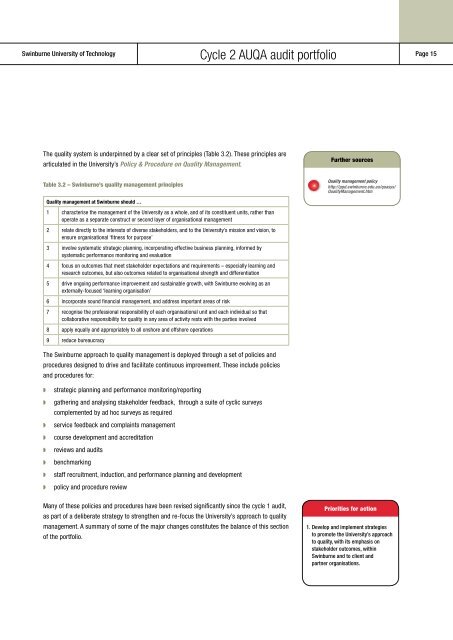pdf - Swinburne University of Technology
pdf - Swinburne University of Technology
pdf - Swinburne University of Technology
Create successful ePaper yourself
Turn your PDF publications into a flip-book with our unique Google optimized e-Paper software.
<strong>Swinburne</strong> <strong>University</strong> <strong>of</strong> <strong>Technology</strong> Cycle 2 AUQA audit portfolio Page 15<br />
The quality system is underpinned by a clear set <strong>of</strong> principles (Table 3.2). These principles are<br />
articulated in the <strong>University</strong>’s Policy & Procedure on Quality Management.<br />
Table 3.2 – <strong>Swinburne</strong>’s quality management principles<br />
Quality management at <strong>Swinburne</strong> should …<br />
1 characterise the management <strong>of</strong> the <strong>University</strong> as a whole, and <strong>of</strong> its constituent units, rather than<br />
operate as a separate construct or second layer <strong>of</strong> organisational management<br />
2 relate directly to the interests <strong>of</strong> diverse stakeholders, and to the <strong>University</strong>’s mission and vision, to<br />
ensure organisational ‘fitness for purpose’<br />
3 involve systematic strategic planning, incorporating effective business planning, informed by<br />
systematic performance monitoring and evaluation<br />
4 focus on outcomes that meet stakeholder expectations and requirements – especially learning and<br />
research outcomes, but also outcomes related to organisational strength and differentiation<br />
5 drive ongoing performance improvement and sustainable growth, with <strong>Swinburne</strong> evolving as an<br />
externally-focused ‘learning organisation’<br />
6 incorporate sound financial management, and address important areas <strong>of</strong> risk<br />
7 recognise the pr<strong>of</strong>essional responsibility <strong>of</strong> each organisational unit and each individual so that<br />
collaborative responsibility for quality in any area <strong>of</strong> activity rests with the parties involved<br />
8 apply equally and appropriately to all onshore and <strong>of</strong>fshore operations<br />
9 reduce bureaucracy<br />
The <strong>Swinburne</strong> approach to quality management is deployed through a set <strong>of</strong> policies and<br />
procedures designed to drive and facilitate continuous improvement. These include policies<br />
and procedures for:<br />
w strategic planning and performance monitoring/reporting<br />
w gathering and analysing stakeholder feedback, through a suite <strong>of</strong> cyclic surveys<br />
complemented by ad hoc surveys as required<br />
w service feedback and complaints management<br />
w course development and accreditation<br />
w reviews and audits<br />
w benchmarking<br />
w staff recruitment, induction, and performance planning and development<br />
w policy and procedure review<br />
Many <strong>of</strong> these policies and procedures have been revised significantly since the cycle 1 audit,<br />
as part <strong>of</strong> a deliberate strategy to strengthen and re-focus the <strong>University</strong>’s approach to quality<br />
management. A summary <strong>of</strong> some <strong>of</strong> the major changes constitutes the balance <strong>of</strong> this section<br />
<strong>of</strong> the portfolio.<br />
Further sources<br />
Quality management policy<br />
http://ppd.swinburne.edu.au/quasys/<br />
QualityManagement.htm<br />
Priorities for action<br />
1. Develop and implement strategies<br />
to promote the <strong>University</strong>’s approach<br />
to quality, with its emphasis on<br />
stakeholder outcomes, within<br />
<strong>Swinburne</strong> and to client and<br />
partner organisations.

















